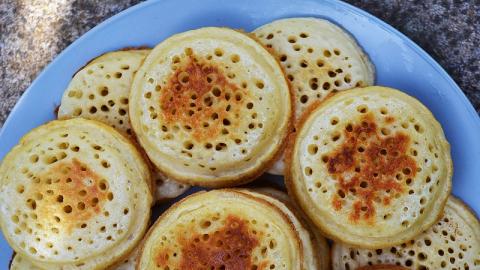
Sourdough Crumpets

Crumpets are one of my favorite things to make and eat, so it’s strange to think that I wasn’t a big fan of them growing up. I found the store-bought variety too dense and quite often stale. Homemade crumpets — on the other hand — are a revelation, and the sourdough variety are a cut above. They taste incredible slathered with marmalade, peanut butter, or a drizzle of maple syrup and served with a side of black tea
Many sourdough crumpet recipes appear to have been invented as a way to use up discarded sourdough starter, as if crumpets are some sort of afterthought, a support act for the more popular line-up of sourdough loaves, pizza and focaccia. While I’m 100% behind minimizing waste, I honestly believe that crumpets deserve their time in the spotlight. Because when they’re made well, they are up there with the best — as good as a plain croissant, or a slice of fresh bread slathered with butter.
That’s why I’d like to give you a recipe that’s specifically for these babies and not a way to repurpose a waste product. Well, that and everyone’s sourdough starter is different. For instance, I keep a relatively low-hydration starter, made up of a blend of rye and bread flours. If my crumpet batter was made up entirely of discarded starter, then a third of it would be rye. I’m a huge fan of rye in my loaves, but in crumpets I find it leads to a denser result.
A nice thing about this recipe is that there is little difference between a starter and a levain, or a ripe starter and a discarded one, so if you’d prefer to use your leftovers — or if your starter is already big enough to cover the quantities I’ve stated — then you can easily adapt it to your needs. Just make sure you aim for the right hydration level and you’ll be singing.
Speaking of hydration, the ratio in this recipe comes in at just under 140%; and paying attention to the batter’s consistency is of utmost importance. By all means, substitute bread flour with another variety, but pay attention to the amount of water your flour likes to soak up — you may need to be sparing with it. I highly recommend reserving some of the water first and only adding in the rest a quarter of a cup at a time if the batter looks dry. You’re after a consistency close to that of thickened cream; still a bit clumpy and thick, but just loose enough to pour off your spoon and conform to the shape of your egg rings. Check out my video for an example of what you’re after.
Even with a lot of care, it’s possible to go too far. If that happens, then a little bit of flour can be added to thicken the mixture up again.
Do also keep in mind that the longer your batter has been sitting around, the weaker it will be; and that means you won’t get as much rise out of your crumpets. That’s another reason I prefer to mix up the batter ad hoc and not use old starter — you have better control over the fermentation.
The sweet-spot for this recipe is somewhere between well-proofed and stale, a mass of batter that has more than doubled in size, in what you’d probably consider over-proofed-land for a loaf of bread. The nice thing about slow ferments is that you have some wiggle room. You can opt to leave this on the bench overnight in the milder months or in the fridge in summer and it should be just-right by morning. The timings below are a general guide for how long to leave the batter fermenting, but be patient and watch for signs of fermentation rather than the clock.
| Temperature | Approximate Proofing Time (hrs) | |
|---|---|---|
| °C | °F | |
| 15 | 59 | 15 |
| 20 | 68 | 7 |
| 25 | 77 | 4 |
| 30 | 86 | 3 |
Once you’ve left the batter sitting for long enough, mix up the baking soda, sugar and water and add them in. What we really want is an overripe ferment that has had enough time to develop nicely and reach the point where it’s started to sour; that twinge of acid is necessary for the baking soda to foam and generate small bubbles. If you use a younger starter, you may need to substitute some of the baking soda for baking powder.
Give it a really good mix; I find that the manual work of whipping up the batter ensures the baking soda is well distributed and gets the aeration really going. It can take a beating, but don’t stress — dough strength is not a huge factor here as the crumpet rings will make sure the crumpets hold their shape, much like a loaf tin.

Now you’re all ready, so preheat your pan. When it comes to cooking these on the stove, use the heaviest-bottomed pan you have available; cast-iron is really the best option here — the frying time is quite long, so you need a slow and strong heat. You’ll likely want to aim for medium to high heat, but be careful — too high and you’ll burn the bottoms, too low and they’ll set before bubbles form. Getting the temperature right will take a bit of practice and I highly recommend you take notes (mental or otherwise) once you get things spot on.
Egg rings are also an essential part of making crumpets; otherwise, you’ll end up with pikelets, and sure, they’ll still taste amazing, but you’ll be missing out on half the fun. Be sure to grease your pan and the egg rings well. I’ve lost count of how many times I’ve cursed at a stray crumpet that gets stuck in its ring. My egg rings are 7cm in diameter, so an 80ml measuring cup makes light work of dispensing the batter.
All up, one round of crumpets should take about 10 minutes to cook on their first side. When their tops have started to dry and harden, flip them over onto the hot pan and leave them for half a minute or until their tops have browned nicely. This last step is another great thing about home-made crumpets, and guarantees they never look as insipid and rubbery as their store-bought counterparts.
Take them off the heat and wait 10 minutes or so for them to firm up; you’ll know that they’ve been successful if a finger pressed lightly into the middle gets some springy resistance. All that’s left to do is slather those griddle cakes with whatever takes your fancy. Honestly, though? Even 10 minutes is a long wait and I’ve been known to sneak in some plain ones at the stovetop. They really are that good; and if you haven’t tried them, then I urge you to put this recipe on your to-do list for next Sunday’s breakfast so you can give them a go too.



Comments
I've made sourdough crumpets a bunch of times in the past and enjoyed them.
Yours look way better than mine ever did. Nice work with the lovely holes on top!
Thanks!
I'd say the holes are down to three things:
There's some amount of trial and error to get it working in any given kitchen.
I think I just put too much batter in my rings :)
I’ve never eaten a crumpet but would be interested in them if I was offered ones that looked as inviting as yours.
Benny
Ah, you're missing out! The home-made kind are far better than store bought, so I'd highly recommend making them (or finding someone who does) if you get the opportunity.
Also, thanks for the nice words. I've been reading your posts for years. Very insightful :).
I just made this exact recipe (found the recipe on FB). I didn't see this thread until after posting it on my blog, lol. They are super easy and came out great!
Mary
Glad to hear it! Looks like they turned out really well. :)